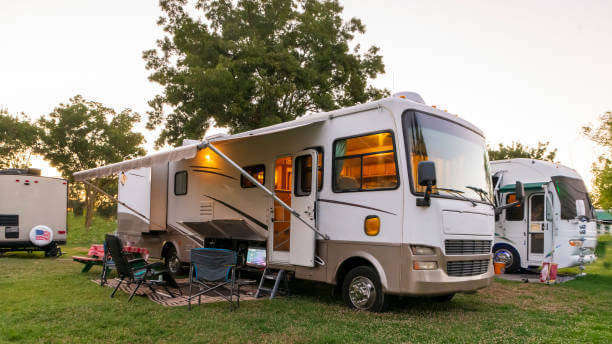The classic American road trip dream often involves an RV and the open road, but as the summer season draws to a close and cooler temperatures take over, it’s time to prepare your RV for winter storage. Ensuring your RV remains clean, comfortable, and road-ready for the next adventure requires careful attention to the interior, exterior, wheels, and engine.
Maximizing RV Winter Storage:
A Comprehensive Guide
Let’s delve into essential RV winter storage tips:
Interior Care: To keep the interior of your RV in excellent shape and prevent the dreaded stale odors that can accompany extended storage, follow these steps:
- Appliance Precautions: Disconnect all appliances and ensure your fridge and freezer are completely defrosted. Prop open the fridge and freezer doors to prevent odors.
- Electrical Disconnect: Since winter storage lasts for several months, disconnect your RV from all electrical sources by flipping off the main breaker on the distribution panel. Additionally, turn off the LP-gas supply valve located on the LP tank.
- Deep Cleaning: Give your cabin and upholstery a thorough cleaning to avoid microbial buildup during storage.
- Ventilation: If you have vent covers that keep water out, open your vents to allow free circulation. To prevent musty smells and deter rodents, consider using Fresh Cab or placing dryer sheets inside.
- Winterize Plumbing: Prepare your plumbing and tanks for winter by flushing them thoroughly with antifreeze.
Exterior Protection: Protecting the exterior of your RV during storage is crucial for extending its lifespan, whether it’s stored in a garage or covered and secured in your driveway:
- Wash and Wax: Prior to storage, give your RV a full wash and wax. This process removes any buildup that may harm the clear coat and paint over the winter. Don’t forget to thoroughly clean the awning if your RV has one.
- Seal Inspection: Check all seals and caulking to ensure your RV is airtight. Repair any damaged seals promptly to prevent moisture and bacteria from entering during the winter.
- Invest in an RV Cover: Consider investing in a quality RV cover. Covers help keep pests out, protect against moisture infiltration through vents, and prevent UV fading of paint and upholstery. They act as a shield against the elements, preserving your RV’s condition.
Safe Parking Practices: Proper parking is essential for maintaining your RV’s tires. Follow these steps to avoid long-term issues during months of storage:
- Flat, Level Surface: Choose a parking spot on flat, level cement. Avoid parking on surfaces that shift with temperature changes, such as dirt or asphalt, as this can lead to improper weight distribution and strain on tires and chassis.
- Use Wood Blocks: Place wood blocks beneath the tires to prevent damage from frozen ground. Ensure the wood is large enough that the tires do not hang over the sides.
- Wheel Chocks: Invest in a set of wheel chocks to securely immobilize your RV, preventing accidental movement and costly damage. Remember to release the parking brake before sealing up your cabin.
- Tire Protection: Keep your RV tires covered or shielded from direct sunlight. Constant exposure to UV rays can degrade rubber, necessitating premature tire replacement.
- Proper Tire Inflation: In colder temperatures, the air in your tires contracts. Inflate your tires to the recommended PSI without exceeding the manufacturer’s capacity to compensate for this contraction.
Engine Maintenance: Protecting your RV’s engine is crucial to avoid costly repairs and ensure a smooth vacation when spring arrives:
- Full Tank and Fuel Stabilizer: Store your RV with a full tank of gas, adding a bottle of fuel stabilizer to preserve the fuel.
- Engine Oil and Fluids: Change the engine oil before preparing for storage and check and fill other fluids as needed. Use winter blend washer fluid to prevent reservoir cracking.
- Battery Care: Remove the batteries before storage and clean them with a 50/50 mixture of baking soda and water. Store batteries in a cool, dry place to prevent freezing or exposure to the elements. Placing batteries on wood is advisable to prevent quick charge drainage on a cold garage floor.
With proper maintenance and storage precautions during the winter months, you’ll be all set to hit the open road as soon as spring rolls around. Safe travels!
Join the E3 Camping Membership today and become a part of a vibrant community that shares your passion for RV adventure. Together, we can make your dreams of RVing and camping a reality, while embracing the spirit of empowerment.

